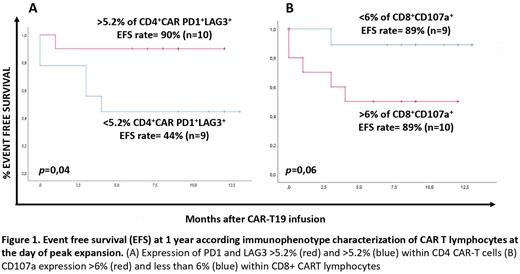Abstract
Introduction CAR-T cell therapy has proven to be a disruptive treatment in the hematology field. Tisagenlecleucel and Axicabtagene ciloleucel showed impressive efficacy in relapsed/refractory B-cell lymphoma; however, less than 50% of patients maintain a long-term response and predictors of outcome are still inconsistently defined. Tisa-cel and Axi-cel kinetics have been poorly investigated in real life settings so it becomes necessary to evaluate possible biomarkers that predict response or toxicity. In clinical trials, the efficacy of the treatment is determined by the in vivo expansion and persistence of CAR-T cells. Real life evaluations assessing the immunophenotypic composition of CAR-T cell infusion products and analyzing how these specific features affect CAR-T cell expansion and persistence in vivo and thus outcome, are scarce. Here, we aimed to optimize the detection of CD19 CAR-T cells in blood and to identify phenotypic features associated with post-infusion expansion and outcomes.
Methods CD19 CAR-T cells were monitored by flow cytometry from peripheral blood in 48 patients with diffuse large B-cell lymphoma, transformed follicular lymphoma, primary mediastinal B cell lymphoma or B-cell acute lymphoblastic leukemia. Flow cytometry approach was performed for determining cell kinetics (n=48) at days 5, 7, 11, 14, 17 and 20 (±1) after CAR-T cells infusion. In parallel, immunophenotype characterization of CAR- T lymphocytes was conducted at the day of CAR-T expansion in blood.
Results After testing different commercially available antibodies for the detection of CD19 CAR-T cells, CD19 protein conjugated with biotin and identified by streptavidin showed the highest resolution in contrast to Antigen CD19 labeled FITC (stain index of 22.19 vs 4.64, p=0.0286). The median day of peak expansion of CAR-T cells was 7 days (range of 5-14 days) after infusion, reaching a median of 119 CAR+ cells/uL (range of 2.4.-1019 CAR+ cells/uL) in blood. Analysis of immune-phenotypic profile of overall circulating T lymphocytes displayed no significant differences in the distribution of naive/memory/effector from CD4+ and/or CD8+ subpopulations between non-CAR T (normal T lymphocytes) and CAR-T cells. However, CAR-T cells showed a significantly higher expression levels of activation (CD69+), proliferation (Ki67+), cytotoxicity (CD107a+) and exhaustion (PD1+TIM3+, PD1+LAG3+) markers in comparison to T lymphocytes (p<0.05). Overall, 31.6% (6/19) patients reached complete remission while 47.4% (9/19) achieved partial response at the first month after CAR-T therapy with event free survival (EFS) of 73% at 1 year (median follow-up of 1 year). Remarkably, cases with lower expression levels of PD-1 and LAG-3 (i.e <5.2%) in CD4+CAR+ T cells at the day of peak expansion had a worse outcome (EFS at 1 year 44% vs 90% for patients with low vs high expression of the above exhaustion markers, p=0.04) (Figure 1A). Similarly, patients with a highly cytotoxicity pattern (i.e CD107a expression >6%) within CD8+CAR+ T cells had a shorter EFS (50%) as compared to those with <6% of CD8+CAR+CD107a+ (89%) (p=0.06) (Figure 1B). Finally, patients with >3.2% CD4-CD8- T cells within the nonCAR T lymphocytes showed superior outcome as compared to those patients who displayed lower levels of double-negative T cells (100% vs 50% of EFS rates, respectively) (p=0.03).
Conclusions In our cohort, the median day of CD19 CAR-T cell peak expansion as assessed by flow cytometry was 7 days after infusion. Markers of exhaustion within the CAR+ population and percentage of double-negative T lymphocytes allows an early identification of prognostic groups in order to guide therapeutic actions.
Disclosures
Perez-Simon:Novartis: Consultancy, Honoraria, Membership on an entity's Board of Directors or advisory committees, Other: Travel, Accommodations, and Expenses; ABBVIE: Research Funding; Janssen: Consultancy, Honoraria, Membership on an entity's Board of Directors or advisory committees, Other: Travel, Accommodations, and Expenses; GILEAD: Consultancy, Honoraria, Membership on an entity's Board of Directors or advisory committees, Other: Travel, Accommodations, and Expenses; JAZZ: Consultancy, Honoraria, Membership on an entity's Board of Directors or advisory committees, Other: Travel, Accommodations, and Expenses; ALEXION: Consultancy, Honoraria, Membership on an entity's Board of Directors or advisory committees, Other: Travel, Accommodations, and Expenses; PFIZER: Research Funding.
Author notes
Asterisk with author names denotes non-ASH members.


This feature is available to Subscribers Only
Sign In or Create an Account Close Modal